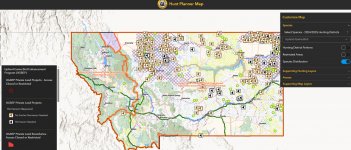I'm far from an expert, but once in a few tries luck into a good spot.
For sharpies I look for cover that averages about shin height (a little less on the tops, and taller in the draws), a variety of plant types (scattered berries, different shades of green when viewed from the road), grasshoppers, and if all of that is within sight of a cut wheat field I start walking. Early season hot sunny afternoons they like to sit in the shade under some shrubs, which may be in lower areas. Otherwise they do often sit up high where they can see danger coming. Instead of kicking your feet up in the evening with a beverage get in your truck and scout. As the sun is going down in good areas you'll often see them flying back into areas where they roost from wherever they've been feeding.
Usually the best I can tell from the map is whether there's a reasonable amount of grasslands in an area. Once you get there it might be grazed down to bare dirt. No amount of E scouting will substitute for getting out in the truck and looking with your own eyes. When you do find birds pay attention. What was in their crop. What does the cover look like (keep that mental picture in your head and update it when you find more). What is on the surrounding properties (look at the surrounding area on a satellite picture).
They like small fields too, not just giant tracks of open grass. Those smaller 1/4 sections, or big fingers of waste grass in an ag field, are a lot easier to hunt without burning yourself and your dog out while you figure things out.
The first couple days I spent chasing sharpies and huns I never saw a single bird. The main thing is not giving up.


